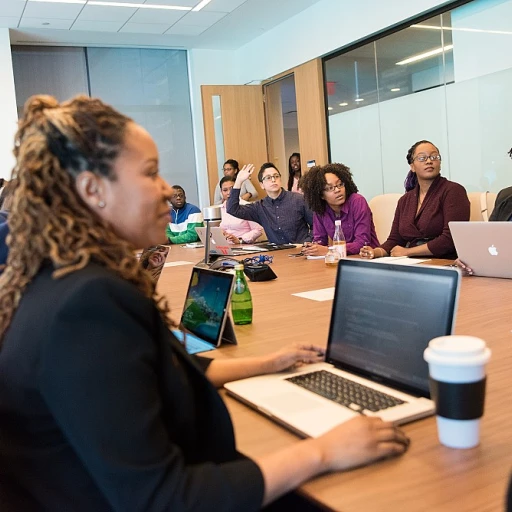
Defining leadership team development in the HR context
What makes leadership team development crucial in HR?
In today’s fast-evolving business landscape, organizations rely on strong leadership teams to drive growth, foster a positive culture, and navigate complex challenges. Leadership team development in the HR context refers to the intentional process of building, nurturing, and strengthening the collective capabilities of leadership teams. This process goes beyond individual leadership development, focusing on how leaders work together as a cohesive unit to achieve organizational goals.
Effective leadership team development helps organizations align their executive team’s vision, enhance decision making, and create a culture where learning and development are prioritized. It’s not just about training individual team members; it’s about developing leadership skills that enable teams to collaborate, solve problems, and adapt to change. When HR leaders invest in team development, they help create an environment where people feel empowered, valued, and motivated to contribute to the organization’s success.
- Encourages cross functional collaboration and innovation
- Strengthens team leadership and communication skills
- Supports the growth of future leaders within the organization
- Promotes a culture of continuous learning and improvement
Leadership team development is not a one-time event. It’s an ongoing journey that involves regular assessment, feedback, and targeted development programmes. HR leaders play a pivotal role in guiding this journey, ensuring that leadership teams remain agile and effective as the organization evolves. For more insights on how consulting solutions can enhance leadership development, explore this resource on enhancing leadership through consulting solutions.
As we explore the challenges HR leaders face in team development, and the core skills needed for success, it becomes clear that investing in leadership team development is essential for building resilient, high-performing organizations.
Key challenges faced by HR leaders in team development
Barriers to Building Cohesive Leadership Teams
Developing a strong leadership team is rarely straightforward. HR leaders often face a mix of organizational and human challenges that can slow down or even derail team development. Understanding these barriers is essential for anyone looking to foster effective leadership and drive business growth.
- Misaligned Goals and Priorities: When team members or departments have conflicting objectives, it becomes difficult to create a unified vision. This misalignment can impact decision making and reduce the effectiveness of leadership teams.
- Lack of Trust and Open Communication: Trust is the foundation of any high-performing team. Without it, team members may hesitate to share ideas, challenge assumptions, or admit mistakes, which stifles innovation and learning.
- Resistance to Change: Organizational culture can sometimes resist new approaches to leadership development. Leaders may be comfortable with the status quo, making it hard to introduce new development programmes or training initiatives.
- Insufficient L&D Support: Many organizations struggle to provide the right learning and development (L&D) resources. Without ongoing training and support, leadership skills can stagnate, limiting the growth of both individuals and the team.
- Poor Role Clarity: Unclear roles and responsibilities can lead to confusion and overlap, making it harder for teams to function effectively. This is especially true in cross functional teams where boundaries are less defined.
- Inadequate Feedback Mechanisms: Regular feedback is crucial for development. Without structured feedback, leaders and team members may not recognize areas for improvement or celebrate progress.
How These Challenges Impact Organizational Growth
When these challenges persist, the organization risks losing momentum in leadership development and team building. Teams may struggle with problem solving, and the overall culture can become less supportive of growth and innovation. This can also affect the ability to develop leadership pipelines and retain top talent.
Addressing these issues requires a proactive approach. HR leaders can help by fostering a culture of learning, encouraging open dialogue, and ensuring that development leadership is a continuous process. For more insights on how strategic HR management can enhance employee engagement and support leadership team development, explore this resource on enhancing employee engagement through strategic HR management.
By recognizing and tackling these barriers, organizations can set the stage for more effective leadership teams and sustainable business growth.
Core skills required for effective leadership team development
Essential capabilities for driving leadership team success
Developing strong leadership teams requires a blend of technical and interpersonal skills. HR leaders play a pivotal role in shaping the growth of executive teams and ensuring that team members are equipped to handle the complexities of modern organizations. Here are some of the core skills that drive effective leadership team development:
- Strategic thinking and decision making: Leaders must be able to see the bigger picture, align team goals with organizational objectives, and make informed decisions that support business growth. This skill is fundamental for any leadership team aiming to navigate change and drive results. For more on how strategic thinking shapes leadership, see this in-depth guide to the role of a business strategist.
- Communication and collaboration: Effective leadership depends on clear, open communication and the ability to foster collaboration across cross functional teams. Leaders need to create a culture where team members feel heard and valued, which is essential for team building and organizational development.
- Emotional intelligence: Understanding and managing emotions—both one’s own and those of others—helps leaders build trust, resolve conflicts, and create a positive team culture. Emotional intelligence is a cornerstone of effective leadership and team development.
- Problem solving and adaptability: Business environments are constantly evolving. Leaders must be able to analyze challenges, adapt quickly, and guide their teams through uncertainty. This flexibility is crucial for sustaining organizational growth and supporting learning and development (l&d) initiatives.
- Coaching and mentoring: Developing leadership within teams involves more than just training. Leaders should actively coach and mentor team members, helping them identify strengths, address weaknesses, and pursue continuous learning. This approach supports both individual and team growth.
These skills are not static—they require ongoing development through targeted training, real-world experience, and feedback. HR leaders can help by designing development programmes that address these areas, fostering a culture of learning, and supporting the growth of both current and future leaders. Investing in these capabilities is key to building high-performing leadership teams that drive organizational success.
Practical strategies for building high-performing leadership teams
Building Trust and Psychological Safety
Creating a culture where team members feel safe to express ideas, challenge assumptions, and admit mistakes is fundamental for leadership team development. Trust is the backbone of effective leadership teams. When leaders foster psychological safety, it encourages open dialogue, honest feedback, and a willingness to take calculated risks. This environment helps teams adapt to change, innovate, and support organizational growth.Encouraging Cross-Functional Collaboration
High-performing leadership teams break down silos and promote collaboration across departments. Cross-functional projects and regular interdepartmental meetings help leaders understand the broader business context and align on shared goals. This approach not only strengthens the executive team but also enhances decision making and problem solving across the organization.Investing in Continuous Learning and L&D Initiatives
Leadership development is not a one-time event. Ongoing learning and development (L&D) programmes, such as workshops, coaching, and peer learning sessions, are essential. These initiatives help leaders refine their skills, stay updated on best practices, and adapt to evolving business needs. Embedding learning into the culture ensures that leadership teams remain agile and effective.Structured Team Building Activities
Regular team building activities, both formal and informal, strengthen relationships among leadership team members. These activities can range from strategic retreats to problem-solving workshops. The goal is to enhance communication, build mutual respect, and align on organizational priorities. Strong leadership teams are built on shared experiences and a clear sense of purpose.Clarifying Roles and Responsibilities
Ambiguity in roles can lead to confusion and conflict. Clearly defining the responsibilities of each team leader and member ensures accountability and streamlines decision making. This clarity supports effective leadership and helps the team focus on delivering business outcomes.- Encourage open communication to build trust
- Promote cross-functional collaboration for broader impact
- Invest in ongoing leadership development and training
- Organize regular team building sessions
- Define roles and responsibilities for all team members
Measuring the impact of leadership team development
Tracking Progress and Outcomes in Leadership Team Development
Measuring the impact of leadership team development is essential for organizations aiming to foster growth and sustain strong leadership. It’s not just about running training sessions or development programmes; it’s about understanding how these efforts translate into real business results and effective team leadership.- Define clear objectives: Start by setting specific goals for your leadership teams. These might include improved decision making, enhanced problem solving, or increased cross functional collaboration. Clear objectives help track progress and align development with organizational needs.
- Use qualitative and quantitative metrics: Combine feedback from team members, leaders, and executive team with measurable data. Surveys, 360-degree reviews, and performance metrics can reveal how leadership development is influencing team culture, engagement, and business outcomes.
- Monitor behavioral changes: Observe how team members apply new skills in real scenarios. Are teams demonstrating more effective communication, better conflict resolution, or stronger leadership in challenging situations?
- Assess organizational impact: Look at broader indicators such as employee retention, productivity, and the ability to develop leadership talent internally. These metrics reflect the long-term value of leadership team development for the organization.
- Continuous feedback and adaptation: Regularly review what’s working and what needs adjustment. Encourage open dialogue among leaders and team members to ensure development initiatives remain relevant and impactful.
Common pitfalls and how to avoid them
Recognizing and Overcoming Common Obstacles
Even the most experienced HR leaders and executive teams encounter pitfalls when driving leadership team development. These challenges can undermine the effectiveness of development programmes and stall organizational growth. By understanding these common missteps, teams can proactively address them and foster a stronger culture of learning and collaboration.
- Neglecting Individual Differences: Every team member brings unique skills, perspectives, and learning styles. Overlooking these differences can lead to disengagement and missed opportunities for growth. Tailoring training and development to individual needs helps unlock the full potential of the leadership team.
- Lack of Clear Objectives: Without well-defined goals, leadership development efforts can become unfocused. Teams should align development initiatives with the organization’s strategic direction, ensuring that every activity supports business priorities and effective decision making.
- Insufficient Feedback Loops: Regular feedback is essential for continuous improvement. Teams that do not establish open channels for feedback and reflection may struggle to identify areas for improvement or celebrate progress. Encourage honest dialogue among team members to support ongoing development.
- Overlooking Cross-Functional Collaboration: Leadership teams often operate in silos, missing out on the benefits of cross functional learning and problem solving. Facilitating collaboration across departments can help teams develop broader perspectives and more innovative solutions.
- Underestimating the Importance of Culture: A strong leadership culture is the foundation of effective team development. Ignoring organizational culture can result in resistance to change and hinder the adoption of new skills or behaviours. Invest in building a supportive environment where learning and growth are valued.
- Failing to Measure Impact: Without tracking the outcomes of leadership development initiatives, it’s difficult to demonstrate value or make informed adjustments. Use relevant metrics to assess progress and ensure that development efforts are driving real business results.
Practical Steps to Avoid Pitfalls
- Engage team members in the design of development programmes to ensure relevance and buy-in.
- Set clear, measurable objectives that align with organizational goals.
- Foster a feedback-rich environment to support continuous learning and improvement.
- Promote cross functional collaboration to enhance team building and broaden leadership skills.
- Regularly review and adapt strategies based on feedback and measurable outcomes.
By staying aware of these common pitfalls and taking proactive steps, HR leaders can help their teams develop strong leadership capabilities, drive effective team leadership, and support sustainable organizational growth.












